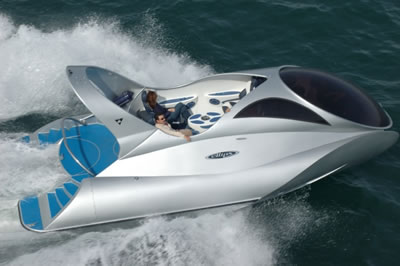|
||
|
|
Boating Participation Increases To 73 Million Americans In 2006
MORE BOATERS -- This remarkable Elorca from Randall Burg Yacht & Ship, Inc. in San Diego is a symbol of the increased participation in recreational boating in 2006. According to the National Marine Manufacturers Association, one-third (73 million) of U.S. adults went boating last year, an increase of approximately 1.3 million Americans from the 2005 total (71.3 million). CHICAGO — One-third (73 million) of U.S adults went boating in 2006, a participation increase of approximately 1.3 million Americans from the 2005 total (71.3 million), according to findings from the National Marine Manufacturers Association's (NMMA ) 2006 Recreational Boating Statistical Abstract , released in May by the association. The abstract highlights boating sales and participation numbers complied on behalf of the recreational boating industry throughout calendar year 2006. Coinciding with the increase in boater participation, the abstract also reveals the number of boats in use increased to nearly 18 million, and boat registrations surpassed 13 million for the first time since 2001. What's more, the industry grew to an all-time high of $39.5 billion in U.S. sales and services in 2006, a 6 percent increase from the previous year. “We are excited to see boater participation increase to 73 million because it reinforces our belief that more and more people are finding out that getting out on the water is one of the best ways to relax, have fun, and enjoy time with friends and family,” says Thom Dammrich, NMMA president. “We are proud of the contribution the boating industry and boat owners make to the U.S. economy, and the marine industry is dedicated to sharing the fun and relaxation of being on the water with as many people as possible.” While total boat unit and dollar sales were up more than 5 percent — buoyed by growth in ski/wakeboard boats, personal watercraft, canoes and kayaks — the traditional powerboat segment saw a decrease in unit sales of nearly 5 percent to 291,900 total units in 2006. “Though new powerboat sales were down slightly, the increase in boating participation bodes well for better sales in the years ahead,” says Dammrich. “We anticipated flat to slightly down powerboat sales as higher interest rates and the malaise in the housing market impacted consumer confidence throughout the year.” Total new-boat dollar sales edged upward 2 percent to $11.5 billion, reflective of an overall increase in the price of traditional powerboats, which also increased two percent to $9.6 billion. NMMA attributes these increases to a rise in production costs for manufacturers, including the escalating price of petroleum-based inputs and efforts to develop cleaner, more fuel-efficient engine technology. “These increases clearly demonstrate boating is well within the reach of average Americans, allowing them an opportunity to make lifelong memories with their families aboard a boat,” says Dammrich. “The Grow Boating Initiative is now in its second year, and we believe it will further increase sales in 2008, 2009, and beyond by demonstrating to would-be boaters the many lifestyle benefits of spending time on the water.” The 2006 Recreational Boating Statistical Abstract is now available, although only a hard-copy format is offered. Copies of the 2006 abstract may be ordered by contacting NMMA fulfillment coordinator Chris Keil at (312) 946-6209 or at orderdesk@nmma.org. For more information on the 2006 Recreational Boating Statistical Abstract , contact NMMA trade communications manager Lindsey Johnson at (312) 946-6204; ljohnson@nmma.org . National Marine Manufacturers Association (NMMA) is the leading association representing the recreational boating industry. NMMA member companies produce more than 80 percent of the boats, engines, trailers, accessories and gear used by boaters and anglers in the United States . The association is dedicated to industry growth through programs in public policy, market research and data, product quality assurance and marketing communications.
|
|
 July
2007
July
2007